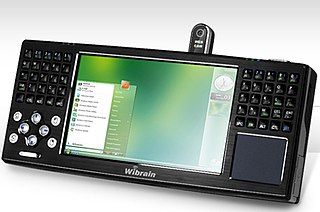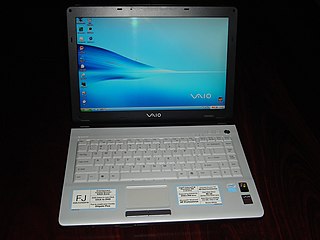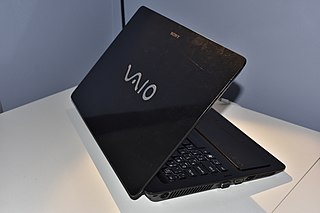Related Research Articles

An ultra-mobile PC is a miniature version of a pen computer, a class of laptop whose specifications were launched by Microsoft and Intel in spring 2006. Sony had already made a first attempt in this direction in 2004 with its Vaio U series, which was only sold in Asia. UMPCs are generally smaller than subnotebooks, have a TFT display measuring (diagonally) about 12.7 to 17.8 centimetres, are operated like tablet PCs using a touchscreen or a stylus, and can also have a physical keyboard. There is no clear boundary between subnotebooks and ultra-mobile PCs, but UMPCs commonly have Major factors other than the common clamshell laptop design, such as having small keys on either side of the screen, or having a slide-out keyboard.
The Vaio VGN-TX2 was a subnotebook, or ultraportable, computer made by Sony.

The Sony Vaio FJ series is a 14.1-inch notebook designed for Windows XP and the FJ270, FJ290, FJ330,FJ370 models in particular, are designed for Windows Vista. The FJ Series uses only the Pentium M processors using the Sonoma platform of Intel Centrino.

Dell Vostro is a line of business-oriented laptop and desktop computers manufactured by Dell aimed at small to medium range businesses. From 2013–2015, the line was temporarily discontinued on some Dell websites but continued to be offered in other markets, such as Malaysia and India.

HP TouchSmart is a series of tablet PC laptops and touchscreen all-in-one desktop computers designed by HP. It features various Intel or AMD processors and runs Windows Vista or Windows 7 as standard.

The Sony Vaio P series is a range of ultraportable subnotebook computers launched in January 2009.
Sony has used the Z model naming scheme for its high-end ultraportable notebook computers since 2000. Unlike other Sony models, the Z has always been manufactured in Japan or in the United States for some models. Sony has stated that production of the Z series will cease at the end of 2012.

The Vaio X series is a line of high-end ultraportable notebook computers from Sony introduced in September 2009, claiming to be the world's lightest notebook, at 655 grams ( ). It features an 11.1", 16:9, 1366x768 LED-lit LCD screen with built-in webcam, 2GB of DDR2 RAM, a choice of 64, 128 or 256 GB SSD, Intel Atom Z540 1.86 GHz or Z550 2.00 GHz, WWAN.
The Sony Vaio TT series was a line of high-end ultraportable notebook computers from Sony introduced in September 2008, with high-end features including an ultra-low voltage Core 2 Duo processor with DDR3 SDRAM; an 11.1", 16:9, 1366x768 LED-backlit LCD screen with built-in 0.3 megapixel webcam; choice of 1.8" hard drive or SSD ; and optional Blu-ray drive. The weight of the laptop is 1.3 kg.

The Vaio S series was a line of notebook computers from Sony introduced in summer 2004. They have been touted as business laptops, and their designs have focused on being thin and light. They also have features friendly to businesspeople, such as TPM chips, matte (anti-glare) displays, RAID SSDs, and extended sheet batteries, as well as continuing to include RJ-45 and VGA (D-Sub) connections.

The Vaio C1 PictureBook was a series of subnotebooks from Sony's Vaio lineup, branded 'PictureBook' for its webcam and video capture capabilities, a first for portable computers. PictureBooks were lightweight computers, weighing 1kg. They featured 8.9" LCD displays, and were notable for being the first consumer laptop with a built-in webcam.

The Sony Vaio 505 series was a line of ultraportable notebook computers from Sony's VAIO brand. The introduction date in the United States was July 24, 1998.

The Vaio F series is Sony's multimedia and gaming orientated laptop series. Launched in January 2010, it replaced the Sony Vaio FW series. Like the preceding model, it features a 16.4" screen, but with Full HD 1920x1080 resolution, 240 Hz refresh rate, and LED backlight. The model came in two choices (VPCF2), 2D or 3D models. The 3D model is included with 3D glasses.
Sony VAIO AR series was a range of high-end multimedia notebook computers from Sony introduced in June 2006 as the first laptop with integrated Blu-ray drive. It replaced the AX Series. It featured a 17" 16:10 widescreen LCD screen, with choice of 1440x900 or 1920x1200 resolutions. It was replaced by the AW series.
The Vaio Y series is a line of notebook computer from Sony introduced in January 2010. It is a netbook-inspired model designed for travel use: compared with the other 13.3" models in the Vaio range, the Y lacks an optical drive, and is heavier and cheaper than the premium Sony Vaio Z series, but lighter than the consumer-grade Sony Vaio S series, with better battery life than either, thanks to the use of CULV processors. The weight is 3.92lbs (1.78kg).
The Sony Vaio FS series is a discontinued range of laptops sold by Sony. It was launched in January 2005 and featured an Intel Pentium M at 1.6 or 1.73 GHz with 512 MB of RAM and Intel GMA 900 or nVidia Geforce 6200 graphics. The screen was a 15.4" 1280x800 display with an 80 GB or 100 GB 4200 rpm hard drive, DVD playback and CD burner and 802.11b/g wi-fi. It weighed 2.9 kg.
The Sony Vaio FZ series is a discontinued model of laptop sold by Sony in 2007. It replaced the Sony Vaio FE series, featuring Intel Core 2 Duo rather than Core Duo CPU, and other improvements. It was criticised for the low-resolution 1280x800 15.4-inch screen, poor battery life and its 2.7 kg weight. It was, however, praised for its display quality and the inclusion of Blu-ray drives on more expensive models.
Lenovo’s line of Essential desktops is a collection of budget-conscious machines designed for consumers, and advertised as being "affordable, space saving, and energy efficient". The Essential desktop line is different from both Lenovo’s ThinkCentre line and Lenovo’s IdeaCentre line. Lenovo defines its ThinkCentre desktops as business-oriented computers, while the IdeaCentre desktops are meant primarily for entertainment. The Essential range of desktops can be categorized as being between the two – meant more for ordinary everyday use.
The Sony Vaio VGX series was a series of living room PCs created for Sony's Vaio line that were released from 2005 until 2008. The VGX series was aimed at consumers who wanted the flexibility of able to watch TV and have the functionality of a computer at the comfort of their living room. All models came built-in with an HDMI port, VHF/UHF output, S-Video, Optical Audio port, and a variation of Microsoft Windows with Media Center installed.
References
- ↑ "Sony VAIO G Series Review".
- ↑ "VAIO Gシリーズ│ パーソナルコンピューター "VAIO" - Sony Style". Archived from the original on 2010-04-19. Retrieved 2010-11-02.